How To Fix Bluetooth Peripheral Device doesn’t have a Driver Windows 7
Introduction:
Bluetooth wireless technology has become widespread in computers, mobile devices, and various electronics to connect accessories and peripherals. Bluetooth allows fast, wireless connections between devices without requiring them to be in the line of sight. When you try to pair a Bluetooth peripheral like a mouse, keyboard, headphones, etc. with your Windows 7 PC, you may encounter the error “Bluetooth Peripheral Device doesn’t have a driver Windows 7” issue.
This annoying error prevents you from using Bluetooth devices with your computer. In this detailed guide, we will understand what is a Bluetooth peripheral, what causes this error, and multiple solutions to fix the “Bluetooth Peripheral Device doesn’t have a driver” problem on Windows 7.
What is a Bluetooth Peripheral Device?
A Bluetooth peripheral is an external hardware device designed to work wirelessly with your computer using Bluetooth connectivity. Unlike desktop computer internal components like sound cards, motherboards, etc., Bluetooth peripherals are external accessories that connect to your computer via Bluetooth instead of wires.
Common examples of Bluetooth peripherals include:
- Bluetooth Mouse – A wireless mouse that connects via Bluetooth to your computer. It requires no wires or dongles.
- Bluetooth Keyboard – A wireless keyboard that pairs with your PC using Bluetooth. Allows typing from a distance.
- Bluetooth Headphones – Wireless headphones that use Bluetooth to connect to your computer or smartphone for audio playback.
- Bluetooth Speakers – External speakers that connect wirelessly to your computer using Bluetooth instead of cables.
- Bluetooth Printers – Printers that can connect wirelessly to your PC using Bluetooth connectivity.
- Bluetooth Game Controllers – Wireless gaming controllers and wheels that pair with your computer via Bluetooth.
- Other Bluetooth devices – Fitness bands, smartwatches, Bluetooth in-car kits, and other electronics that use Bluetooth to connect wirelessly.
What Causes the “Bluetooth Peripheral Device doesn’t have a Driver Windows 7” Error?
There are several potential reasons why Windows 7 may show the “Bluetooth Peripheral Device doesn’t have a driver” error when trying to use a Bluetooth accessory:
- Missing Bluetooth Drivers
For Bluetooth peripherals to work, Windows 7 requires their respective drivers to be installed. If the drivers are missing or not present, you’ll see the error message when connecting that Bluetooth device.
- Corrupt or Outdated Drivers
Existing Bluetooth drivers on your system may have become corrupt or outdated over time. This prevents proper communication between Windows and the Bluetooth peripheral.
- Incompatible Drivers
Using generic or incompatible Bluetooth drivers can trigger this error if they don’t match the hardware.
- Disabled Bluetooth Service
The default Bluetooth USB host controller service needs to be enabled and running for Bluetooth devices to work on Windows 7.
- Bluetooth Adapter Issues
Faulty or damaged Bluetooth adapters, USB ports, or motherboard components related to Bluetooth connectivity can cause driver errors.
- PC Firmware Problems
Outdated BIOS/UEFI firmware or incorrect firmware settings may affect Bluetooth drivers and functionality.
- Software Conflicts
Conflicts with anti-virus software or VPN clients can sometimes interfere with Bluetooth services on Windows 7.
Now let’s discuss the step-by-step solutions and troubleshooting methods to resolve the “Bluetooth Peripheral Device doesn’t have a driver” problem on Windows 7.
How to Fix Bluetooth Peripheral Device Doesn’t Have a Driver Windows 7 Issue?
Solution 1: Update Bluetooth Drivers
The initial step in troubleshooting involves verifying driver updates. To update Bluetooth drivers on Windows 7, adhere to these guidelines:
Step 1: Go to Start > Control Panel > Device Manager. Alternatively, press the Windows + R key combination type “Devmgmt. msc” and hit Enter to open Device Manager.
Step 2: In the Device Manager, expand the “Bluetooth Radios” section.
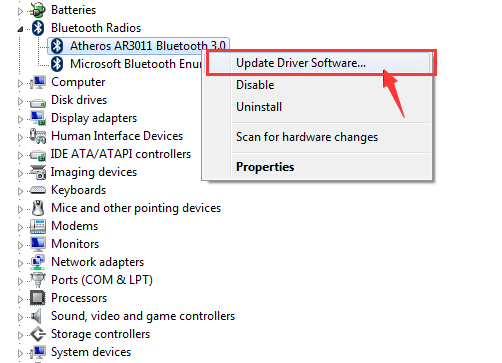
Step 3: Right-click on the Bluetooth adapter and select the Update Driver Software option.
Step 4: Choose ‘Search Automatically for updated driver software’.
Step 5: Restart your computer and check if the Bluetooth peripheral works.
Updating to the latest Bluetooth drivers often resolves driver errors with Bluetooth peripherals. Allow Windows to automatically search online and install the correct drivers from the device manufacturer.
Solution 2: Uninstall and Reinstall Bluetooth Drivers
If updating drivers didn’t help, try uninstalling and reinstalling the drivers by following these steps:
Step 1: In Device Manager, right-click on the Bluetooth adapter and select Uninstall Device.
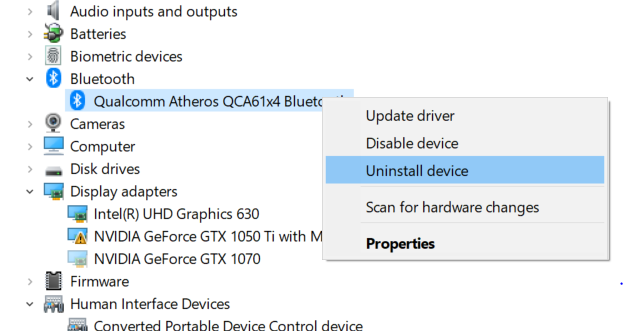
Step 2: Also uninstall any other Bluetooth-related devices shown in Device Manager.
Step 3: Restart your computer and Windows will automatically reinstall the standard Bluetooth drivers.
Step 4: Try pairing your Bluetooth device again.
Reinstalling drivers can fix corrupt, misconfigured, or incompatible drivers that may be causing the issue. This refresh often fixes Bluetooth peripheral driver problems.
Solution 3: Check Bluetooth Service
Step 1: Go to Start type “services.msc” and open the Services management console.
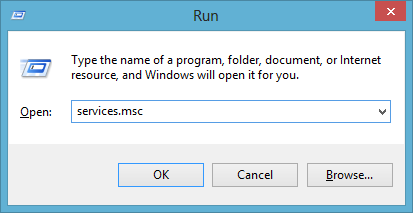
Step 2: Locate the “Bluetooth Support Service” and check its status.
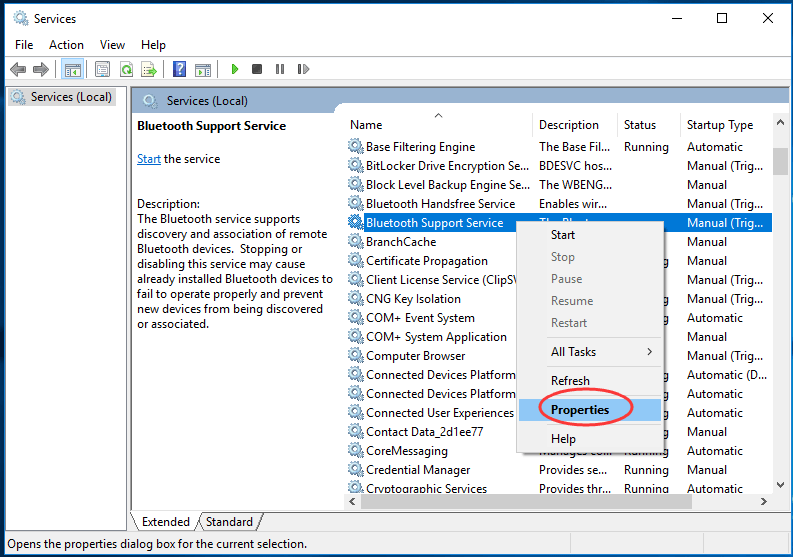
Step 3: If its Status is Disabled or Manual, right-click it, select Properties, and set Startup Type to Automatic.
Step 4: Click Apply, then OK. Restart your PC.
This makes sure the core Bluetooth service is enabled in Windows 7 so your Bluetooth peripherals can function normally. So, try this solution and check if it helps in fixing the Bluetooth peripheral device that doesn’t have a driver Windows 7 error.
Solution 4: Toggle Bluetooth Power Saving Mode
Step 1: Go to Device Manager > Bluetooth adapter properties > Advanced tab
Step 2: Uncheck the option ‘Allow the computer to turn off this device to save power’.
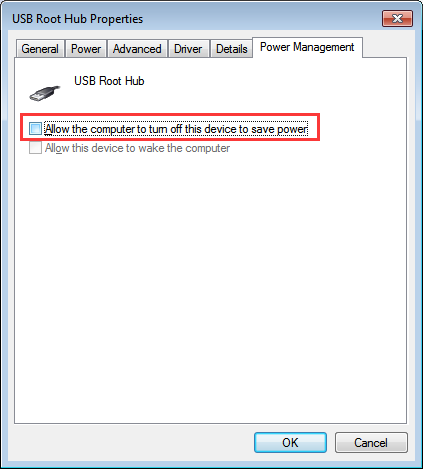
Step 3: Restart your computer and try reconnecting the Bluetooth peripheral.
Turning off the power-saving mode for Bluetooth can resolve intermittent connectivity issues with Bluetooth mice, keyboards, etc. due to power management features.
Solution 5: Update BIOS/Firmware
Verify the manufacturer’s website for any accessible BIOS or firmware updates of your computer. Implement the most recent BIOS update to resolve potential driver errors associated with the motherboard, Bluetooth adapter, or USB functions. Ensure to select the appropriate update compatible with your specific computer model.
Solution 6: Try a Bluetooth USB Adapter
As a last resort, use an inexpensive external USB Bluetooth 4.0+ adapter. Attach it to your computer, install the latest drivers, and try connecting your Bluetooth peripherals. A USB adapter can help determine if the onboard Bluetooth adapter is faulty or needs replacement.
If your devices connect successfully via the external adapter, it indicates a potential issue with the internal Bluetooth hardware. However, if the problem persists, consider checking for interference from other devices or updating the firmware of your peripherals. Additionally, consult the manufacturer’s support for further troubleshooting steps.”
Conclusion
Updating drivers, toggling services, adjusting firmware, or using a USB adapter can help troubleshoot and resolve the “Bluetooth Peripheral Device doesn’t have a driver Windows 7 issue” Follow the solutions step-by-step to identify and fix the underlying problem. This will allow you to successfully use wireless Bluetooth peripherals like headsets, gamepads, keyboards, mice, and other accessories with your Windows 7 PC.
Popular Post
Recent Post
How To Adjust Display Appearance Settings Easily in Windows 11/10
Learn to adjust display appearance settings easily Windows offers. Simple guide covers brightness, scaling, resolution & multi-monitor setup for better screen experience.
Supercharge Your Productivity: A Solopreneur’s and SMB’s Guide to Mastering Google Workspace with Gemini’
Picture this. It’s Monday morning. You open your laptop. Email notifications flood your screen. Your to-do list has 47 items. Three clients need proposals by Friday. Your spreadsheet crashed yesterday. The presentation for tomorrow’s meeting is half-finished. Sound familiar? Most small business owners live this reality. They jump between apps. They lose files. They spend […]
9 Quick Tips: How To Optimize Computer Performance
Learn how to optimize computer performance with simple steps. Clean hard drives, remove unused programs, and boost speed. No technical skills needed. Start today!
How To Speed Up My Computer/Laptop Windows 11/10 [2025]
Want to make your computer faster? A slow computer can be really annoying. It takes up your time and makes work more difficult. But with a few easy steps, you can improve your laptop’s speed and make things run more smoothly. Your computer slows down over time. Old files pile up. Programs start with Windows. […]
How To Fix Low Disk Space Error Due To A Full Temp Folder
A low disk space error due to a full temp folder is a common problem. Many users face this issue daily. Your computer stores temporary files in special folders. These files ensure optimal program performance, but they can accumulate as time goes on. When temp folders get full, your system slows down. You might see […]
How to Use Disk Cleanup on This Computer: Step-by-Step Guide
Computers getting slow is just the worst, right? Well, yes! Files pile up on your hard drive. Luckily, the Disk Cleanup tool on your PC is here to save the day. It clears out unnecessary files, giving your system the boost it needs to run smoothly again. A lot of users aren’t aware of the […]
Top 25 Computer Maintenance Tips: Complete Guide [2025]
Computer maintenance tips are vital for every PC user. Without proper PC maintenance, your system will slow down. Files can get lost. Programs may crash often. These computer maintenance tips will help you avoid these problems. Good PC maintenance keeps your computer running fast. It makes your hardware last longer. Regular computer maintenance tips can […]
Reclaiming Disk Space On Windows Without Losing Files: A Complete Guide
Running low on storage can slow down programs and trigger that annoying “low disk space” warning. Files accumulate over time, cluttering the drive. The good news? It’s possible to reclaim space without deleting anything important. Reclaiming disk space on Windows without losing files is easier than you think. Your computer stores many temporary files, old […]
Fix Issues Downloading From the Microsoft Store on Windows 11, 10 PC
Do you get excited when you’re about to download a new app or game? You open the Microsoft Store, click the download button… but nothing happens. Or maybe it starts and then suddenly stops. Sometimes, strange messages pop up like “Something happened on our end” or “Try again later.” That can be really annoying. But […]
Fix Low Disk Space Errors Quickly On Windows 11, 10 PC [2025]
Low disk space errors can slow down your Windows PC. These errors appear when your hard drive runs out of room. Your computer needs space to work properly. When space runs low, programs crash and files won’t save. Windows shows warning messages about low disk space. Your PC may freeze or run slowly. You might […]



























